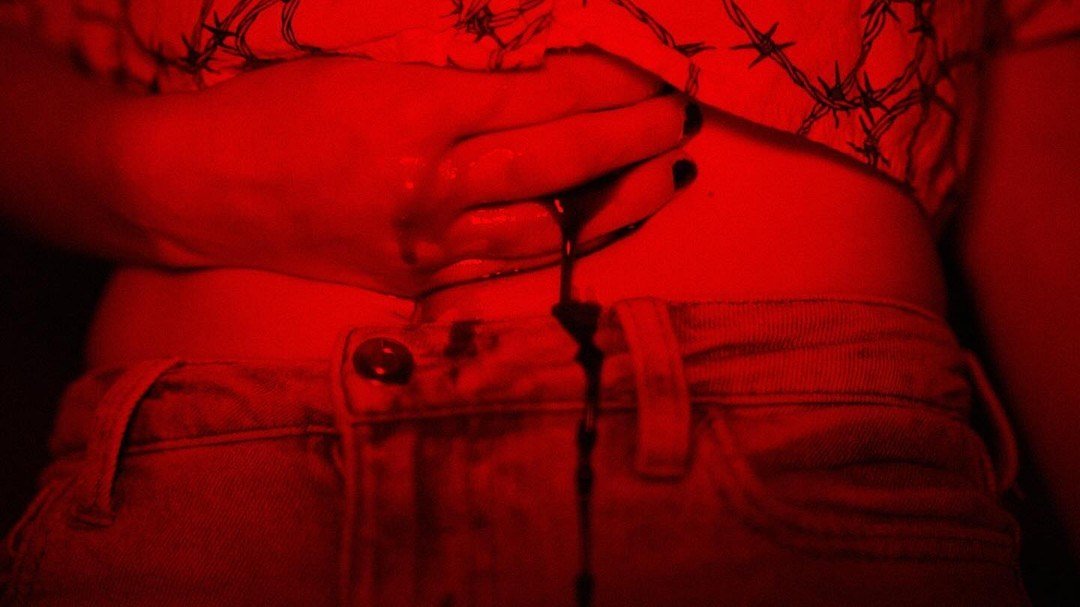You can feel microbudget filmmaker Dillon Brown stretching his artistic wings with his latest, The Summer We Died. His previous efforts have all been variations on the found footage/mockumentary subgenre. Here, he utilizes a more traditional storytelling approach, albeit one that’s not completely devoid of stylistic flourishes. It’s also different in that it has a large-ish ensemble cast, as opposed to focusing on one or two characters.
Reno, Nevada is gripped by fear, as there is seemingly a serial killer (nicknamed “the Moonlight Killer) on the loose. However, many of the local teens don’t seem to be treating the situation with the caution it deserves. This is especially the case with M (Amanda Morgan), Darlin’ (Grace Winters), and Baby Girl (Hannah Welty). The trio is determined not to spend their last teenage summer together locked up with their parents (salt of the earth Brian Lee, drunken sad sack John Potash, levelheaded Matthew Nielson, and domineering Annie Lain). The girls hang out at a skate park and at beer bash parties despite their guardians’ best efforts. Meanwhile, the murderer continues to ply their trade.
We also get Zoogie Austin as a dude with a knack for showing up at the right time, Nomar Mendoza as a budding film student, Blake Hyer as a no-nonsense security guard, Maxwell Golden as an aggressive partygoer, Nicolas Bullentini as a skater douchebag, and Dustin Tamplen (who also assisted with special effects) as a jerk at a concert. Brown’s frequent collaborator, Michael Rock, puts on his producer and art director hats while also playing a guy who doesn’t take no for an answer. Brown himself provides some voiceover work as a radio announcer and also shows up in a bit part late in the film.
Brown’s script is adept at concealing where the story is headed. For most of the 73-minute runtime, I wasn’t sure if he was going to be able to pull together his various threads or even if there was going to be a point to what was happening. However, I was genuinely surprised by how the climax tied everything up in a nice tidy bow. I won’t be elaborating any more than that, as I hope the piece works in a similar fashion for you.
Character work is efficient and lean, but we get a nice sense of the personalities of most of our principals. Dialog is reasonably naturalistic. I’m guessing a few of the sequences involved some improvisation, like when Darlin’ gets into an argument with her parents. This gifted some of the character interactions a looser feel and it fits in nicely with the overall aesthetic. Additionally, Brown allows a few characters to deliver some brief voiceover narrations and, most interestingly, to directly address the audience in fourth-wall-breaking soliloquies.
There are a few themes at work in The Summer We Died, as well. Misogyny is a major one and the subtext that is the most thoroughly explored. Multiple scenes detail the girls dealing with the unwanted advances of creepy men. Bigotry against minorities is another, but that really only becomes apparent as the plot coalesces toward the end. I would also describe it as a coming-of-age piece of sorts.
The most obvious departure from Brown’s previous efforts is the overall look of the film. Now, I’m not sure if he shot it with three different types of cameras or if the presentation is just the result of editing aftereffects, but it’s certainly convincing. Most of the time, a standard digital movie-type camera is used (sorry, I’m not techy enough to be able to discern camera models, specific film stocks, etc). Here and there, though, we get shots from Mendoza’s mini DV camera, and some stuff that looks like it was shot with a camcorder, which shifts the aspect ratio and helps to vary the imagery. Brown also intermittently slathers the screen with superimposed scribbles and doodles that look like something you’d find on a teenager’s school notebook. Combine all this with the near-constant whooshing handheld movement and some off-kilter angles and the result is a highly engaging watch.
All of the performers look comfortable in front of the camera. Morgan exudes troubled girl-next-door charm. Winters is nice as the most overtly rebellious member of the group. Annie Lain impressed me in Rock’s recent solo directorial outing, The Murder of the Monster, and she puts in good work here as a bit of a Karen. Potash delivers my favorite turn as M’s alcoholic single dad dealing with his wife’s unceremonious departure. Now, none of this is going to be mistaken for Hollywood levels of acting, but we’re talking about a movie with a less than $5k budget. I’d say that, with that in mind, everyone puts in admirable work.
Music plays a large part in The Summer We Died’s overall mood. The soundtrack often blasts raucous punk tracks which marry well with the numerous sequences involving skating, partying, and hanging out. There is also some footage of metal band Acid Box putting on a live performance. In conjunction with the lively visuals and Brown’s deceptively deft editing, the atmosphere reminded me of mid-’90s era MTV music videos and programming.
This essentially being a movie about a serial killer, we should probably discuss the gore. Of the Brown films that I’ve seen, The Summer We Died is far and away the grisliest. Though it’s far from a splatter film, there are a few instances of legitimately nasty grue. Two of the kill sequences specifically wouldn’t look out of place in a movie with ten times this one’s budget. It’s nice work.
Dillon Brown’s The Summer We Died is a nice step forward for the writer/director/producer/editor/you get the picture. Stylistically, it’s a massive departure from his previous films. That’s not inherently good or bad, but it’s always nice to see an artist try something different. The film is currently making the rounds on the festival circuit, but I would expect to see it show up on streaming services in the near future. I recommend it to fans of Mid90s, My My So-Called Life, and Totally Killer (keeping in mind its much lower budget).
Michael Cavender





